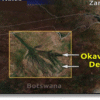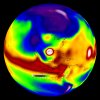Climate & Earth Science
NERSC users have made significant and long-lasting improvements to the scientific basis for assessing the potential consequences of climatic changes and costs of alternative response options. Efforts using higher resolution, improved physical, chemical, and biological process representations, and more precise uncertainty estimates continue to explore potential ecological, social, and economic implications of climatic change.
In addition, NERSC researchers work in a variety of Earth modeling activities, including geophysical and molecular dynamics representations of the Earth's composition; studying processes involved in using geophysical reservoirs to extract and store carbon dioxide so as to eliminate greenhouse gas from the atmosphere; and detailed examination of clay-mineral interfaces. These wide ranging investigations have a common emphasis on supporting DOE's science mission by providing basic research to underpin the nation’s strategy for understanding and mitigating the terrestrial impacts of energy technologies.
Representative examples of research in these vital areas appear below.
Human-Induced Climate Change Reduces Chance of Flooding in Okavango Delta
First-ever study of its kind produces counter-intuitive result but solid explanation. Read More »
Long Fingers of Heat Beneath Earth's Surface
New model of Earth's interior reveals channeled flow structures that explain hotspot volcanism Read More »
Tundra Bushes Add Fuel to Northern Thaw
Another Climate Feedback – The Influence Of Shrub Height In Tundra Regions On Northern High Latitude Climate Read More »
Climate Change Simulations with CCSM & CESM
NCAR scientists continue to perform fundamental research into understanding processes that influence the natural variability of the earth’s climate system, and relate those processes to possible future manifestations of anthropogenic climate change. Read More »
20th Century Reanalysis Project
This project uses an Ensemble Kalman filter to reconstruct global weather conditions in six-hour intervals from 1871 to the present. The aim is to validate tools for future projections by successfully recreating -- and explaining -- climate anomalies of the past. Read More »












